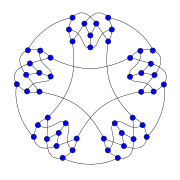Szekeres snark: Difference between revisions
Appearance
Content deleted Content added
mNo edit summary |
|||
| Line 34: | Line 34: | ||
[[Category:Regular graphs]] |
[[Category:Regular graphs]] |
||
[[Category:Graphs of vertices 50]] |
|||
[[Category:Graphs of edges 75]] |
|||
[[Category:Graphs of radius 6]] |
|||
[[Category:Graphs of diameter 7]] |
|||
[[Category:Graphs of girth 5]] |
|||
[[Category:Graphs of automorphisms 20]] |
|||
[[Category:3-chromatic graphs]] |
|||
[[Category:Graphs of chromatic index 4]] |
|||
{{combin-stub}} |
{{combin-stub}} |
||
Revision as of 11:25, 11 April 2016
| Szekeres snark | |
|---|---|
 The Szekeres snark | |
| Named after | George Szekeres |
| Vertices | 50 |
| Edges | 75 |
| Radius | 6 |
| Diameter | 7 |
| Girth | 5 |
| Automorphisms | 20 |
| Chromatic number | 3 |
| Chromatic index | 4 |
| Properties | Snark Hypohamiltonian |
| Table of graphs and parameters | |
In the mathematical field of graph theory, the Szekeres snark is a snark with 50 vertices and 75 edges.[1] It was the fifth known snark, discovered by George Szekeres in 1973.[2]
As a snark, the Szekeres graph is a connected, bridgeless cubic graph with chromatic index equal to 4. The Szekeres snark is non-planar and non-hamiltonian but is hypohamiltonian.[3]
Another well known snark on 50 vertices is the Watkins snark discovered by John J. Watkins in 1989.[4]
Gallery
-
The chromatic number of the Szekeres snark is 3.
-
The chromatic index of the Szekeres snark is 4.
-
Alternative drawing of the Szekeres snark.
References
- ^ Weisstein, Eric W. "Szekeres Snark". MathWorld.
- ^ Szekeres, G. (1973). "Polyhedral decompositions of cubic graphs". Bull. Austral. Math. Soc. 8 (3): 367–387. doi:10.1017/S0004972700042660.
- ^ Weisstein, Eric W. "Hypohamiltonian Graph". MathWorld.
- ^ Watkins, J. J. "Snarks." Ann. New York Acad. Sci. 576, 606-622, 1989.


